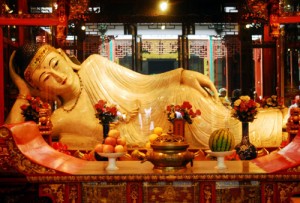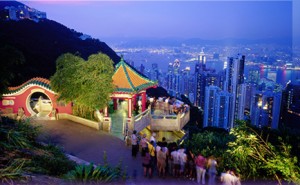This article is written by Justin Rabindra. Justin is a Manager with an Advertising Agency in Delhi. He is also an avid traveler and photographer.
This article is written by Justin Rabindra. Justin is a Manager with an Advertising Agency in Delhi. He is also an avid traveler and photographer.
The Xihoumen Bridge (simplified Chinese: ?????; traditional Chinese: ?????) is a suspension bridge built on the Zhoushan Archipelago, the largest offshore island group in China. The main span was completed in December 2007. The entire bridge, along with Jintang Bridge, was opened to traffic on a test basis on 25 December 2009. It is the second-longest suspension bridge ranked by the length of the centre span. The opening date was put off because of a ship collision on 16 November 2009 that slightly damaged the side of Jintang Bridge.
The 5.3-kilometre-long suspension bridge connection has a 2.6-kilometre-long main bridge with a central span of 1, 650 metres. The approaches total 2.7 kilometres. When it opened, there was only one bridge with a larger span, the Akashi-Kaikyo Bridge in Japan. However, there are several other bridges planned or under construction that will also be larger.
The bridge was built by the province of Zhejiang, at a cost of 2.48 billion yuan (approximately US$363 million). Construction began in 2005, and the first traffic crossed the bridge on 25 December 2009, at 11:58 p.m., local time.
The Xihoumen Bridge links Jintang and Cezi islands. Another bridge, the 27-kilometer-long cable-stayed Jintang Bridge, links Jintang Island and Zhenhai of Ningbo. The two bridges are the second phase of a huge project started in 1999 to link the Zhoushan Archipelago to the mainland with five bridges. Construction of the other three bridges has been completed.
Source: Wikipedia
With a seemingly endless array of hotels and new ones springing up all the time, it can be hard work searching for a decent room in Shanghai. Below is a guide to the city’s most fabulous accommodations, from five-star stunners housed in towering skyscrapers to beautifully renovated pre-war villas.
Hotels seeped in history
The Mansion Hotel combines historic charm and modern luxury like no other hotel in the city. The beautiful 1930s building was originally the residence of Sun Tingsun, a business partner of Huang Jinrong and Du Yueshang, two of Shanghai’s most powerful gangsters. It was used as offices for the trio’s business dealings and was a venue for some of Shanghai’s most extravagant parties.
Stepping through the front door is like stepping back in time to the city’s glorious, notorious past. The lobby, the corridors and the rooms are filled with antiques – a box camera here, a gramophone there, an old pistol in one cabinet, original company documents in another. But it is more than a museum. There is exquisite luxury too. Your feet sink into the carpet as you enter the rooms, which are all huge and come with beautifully-upholstered wood furniture, big-screen satellite TVs, wi-fi, a double-sized shower and, best of all, a private jacuzzi.
The Astor House Hotel, Shanghai
The Astor House, a distinguished elderly gentleman, was Shanghai’s very first hotel, originally built as the Richards Hotel in the latter part of the Qing dynasty in 1846. More than 160 years on, there remains a distinct air of elegance, with the hotel’s original wooden flooring still covering some of the halls and corridors. Rooms are by no means luxurious when compared with some of Shanghai’s five-star offerings, but unlike its flashier competitors Astor House offers guests the opportunity to stay in rooms once occupied by the likes of Albert Einstein, Bertrand Russell and Charlie Chaplin.
This article is written by Zara Murao
Lhasa is nothing like you’d imagine. No rickety wooden shops or quaint winding lines. Everywhere you look in the capital of Tibet are bright red stores, malls and shopping centres. The roads are ruler-straight and in mint condition, as if they mean business. Young Chinese men and women — the latter very fashionably turned out in impeccable boots and stylish stilettos — strut to work. If the language is Mandarin, the food is largely Cantonese. Local delicacies like tsampa — flour made from roasted barley mixed with buttery tea — or yak milk butter and cheese are not on the menus of most hotels and restaurants.
 Tsampa (Zanba in Chinese), hullessbarley fried noodles, staple food for Tibetans
Tsampa (Zanba in Chinese), hullessbarley fried noodles, staple food for Tibetans
There’s pork instead. Lots of it. And each meal can easily take an hour and a half as course after delicious course, often a total of 14 dishes, is brought steaming to the table.
Ancient rites
As you nibble on curried yak stomach, you might wonder where the real Tibet is. Which is why you should time your visit to coincide with the Shoton (Yogurt) Festival, usually in the latter half of August. The biggest festival after the Tibetan New Year, Shoton dates back about 1, 000 years and is celebrated to mark the end of the monks’ annual summer meditation retreat.
This article is written by Abhik Dutta
1. They are very polite and disciplined.
2. They are many.
3. Chinese cuisine is NOT bland. Sample the Sichuan cuisine – try Chicken fry Sichuan style at Made in Beijing (Jiangtai Road, Chaoyang) or at Shanshujian (.com.cn)!
4. There is a superb vegetarian fine dining Chinese restaurant – Pure Lotus at the erstwhile Holiday Inn Lido (now called Metropark Lido).
5. Most places have names that are unpronounceable. Get used to it.
6. Beijing subway is cheap -Yuan 2 for one-time unlimited ride. And its very user friendly (except for point no. 5 above)
7. There is a shop in Chaoyang called ‘Made in China- Original.’
8. They are trying very hard with their English. Period.
9. The ‘Legend of Kungfu, ’ show, based on Shaolin Martial Arts, opens every night at 5.15pm and 7.30pm at the Red Theater in Xingfu Avenue, Dongcheng and is definitely worth a dekho. Go for the ground floor seating (the upper floor seats don’t have great views of what’s happening at the edge of the stage and in front of it).
10. Myth: You don’t get veg food at The Wangfujing Snacks Street. Reality: Of course you do. I sampled skewered watermelon and strawberries!
Abhik Dutta
2 June 2011
http://www.thewanderers.travel/blog/index.php/24-hours-in-beijing-my-ten-chinese-takeaways-abhik-dutta/
This article is written by Veer Singh
 The reclining Buddha at the Jade Buddha temple, Shanghai
The reclining Buddha at the Jade Buddha temple, Shanghai
Going to China, the third largest country in the world with a population more than that of India, one would not expect much to enjoy in Shanghai but to my surprise the city has a lot to offer. Right from Yu Garden to Jade Buddha Monastery, the city gave us a feel of being close to culture. The visit to the silk factory and pearl factory made our pocket lighter but it made my wife happy. While waiting for the acrobatic show in the theatre we remembered our young days in India watching the city circus. It was sheer display of absolute synchronisation with a perfect use of light and sound.
 Lookout Point at Victoria Peak, Hong Kong
Lookout Point at Victoria Peak, Hong Kong
From Shanghai’s traditional Chinese flavour everywhere, we got a taste of Hong Kong’s dynamism from the vantage point of Victoria Peak, overlooking the world’s busiest deep water port. Here you see a city geared not only to making money but feeling good about it too. At night it was like looking down into a volcano. Despite its British colonial past, Hong Kong has always stuck to its root and the culture beneath the glitz is pure Chinese. Visitors like us often takes a few days in Hong Kong to get accustomed to the whirlwind pace. Our respite came at the dinner at Bombay Dreams, an Indian restaurant, where ghazals were being played.
A day trip to Disneyland got the children in us enjoying to the hilt. The apprehension before reaching out to these cities was gone in just four-five days but we guess that’s a lot to do with the company you are with.
Veer Singh
21 Aug 2011
http://travel.hindustantimes.com/travelogues/hong-kong-has-a-lot-to-offer-to-the-tourists.php
This article is written by Meena Venkataraman, who is one of India’s leading travel writers with extensive travel experience.
China fascinated…Five long years after I first visited I can still vividly remember the five weeks I spent there. For no good reason I decide I would go through with the exercise of blogging about it.So here I go..
Huanglong (literally “yellow dragon”) is a scenic and historic interest area in the northwest part of Sichuan, People’s Republic of China. It is located in the southern part of the Minshan mountain range, 150 kilometres (93 mi) north-northwest of the capital Chengdu. This area is known for its colorful pools formed by calcite deposits, especially in Huanglonggou (Yellow Dragon Gully), as well as diverse forest ecosystems, snow-capped peaks, waterfalls and hot springs. Huanglong is also home to many endangered species including the Giant Panda and the Sichuan Golden Snub-nosed Monkey. Huanglong was declared a World Heritage Site by UNESCO in 1992.
Due to thousands of years of geological evolution, Huanglong consists of numerous unique landscapes of geological landforms. Glacial revolution, terrane structure, stratum of carbonic acid rock, tufa water and climatic conditions such as artic-alpine sun light have created this world-famous travertine landscape.
 The travertine landscape and pools of Huanglong
The travertine landscape and pools of Huanglong
The main body of water starts from the ancient Buddhist/Benbo temple at the top of the valley and ends at Xishen Cave Waterfall in the north with a length of 2.5 km and a width of 30 – 170m. The colours of Huanglong’s waters consist of yellows, greens, blues and browns.
Source: Wikipedia
Xinjiang Museum, Urumqi
Yesterday, we visited the Xinjiang Museum where we saw the amazing and intriguing mummies – some more than 4000 years old – which have been found in the area.
We took a stroll through the Red Hill Park on a cold a blustery autumn day. We were glad we had gloves and scarves! There were a few families out walking, and more appeared as the sun came out.
There was some confusion about our hotel. The one we were supposed to stay at had been pulled down a year ago! It was half way through a complete re-build.
But we were ‘upgraded’ to a 5* hotel, which was fine – nothing special; a typical ‘business’ hotel – could have been anywhere in the world.
25th October:
Our last day in China, and we ended on a high note with a journey into the snow-capped mountains to visit Heavenly Lake, 2000 metres up in the Tian Shan mountains. We had read about this lake in 1987 in Vikram Seth’s travel book From Heaven Lake. We had never imagined that one day we would visit it ourselves! We were so lucky. Two days before it had started snowing, and the whole area had turned into a magical Christmas card scene – as the blurb says:
“Nestling among Alpine scenery, with melted snow as its source, lies Heavenly lake. Its crystal clear waters are surrounded by green pastures dotted with the yurts of nomadic Kazakhs, and the silvery mountains soar into the blue sky, their slopes full of fragrant pine and juniper”
I couldn’t have put it better myself!
Krishnad
October 2009
http://blog.travelpod.com/travel-blog-entries/krishnad/1/1256463776/tpod.html